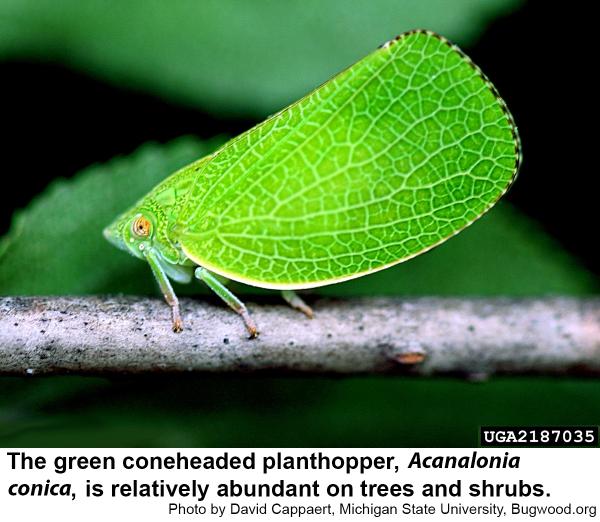What Is a Planthopper?
go.ncsu.edu/readext?869102
en Español / em Português
El inglés es el idioma de control de esta página. En la medida en que haya algún conflicto entre la traducción al inglés y la traducción, el inglés prevalece.
Al hacer clic en el enlace de traducción se activa un servicio de traducción gratuito para convertir la página al español. Al igual que con cualquier traducción por Internet, la conversión no es sensible al contexto y puede que no traduzca el texto en su significado original. NC State Extension no garantiza la exactitud del texto traducido. Por favor, tenga en cuenta que algunas aplicaciones y/o servicios pueden no funcionar como se espera cuando se traducen.
Português
Inglês é o idioma de controle desta página. Na medida que haja algum conflito entre o texto original em Inglês e a tradução, o Inglês prevalece.
Ao clicar no link de tradução, um serviço gratuito de tradução será ativado para converter a página para o Português. Como em qualquer tradução pela internet, a conversão não é sensivel ao contexto e pode não ocorrer a tradução para o significado orginal. O serviço de Extensão da Carolina do Norte (NC State Extension) não garante a exatidão do texto traduzido. Por favor, observe que algumas funções ou serviços podem não funcionar como esperado após a tradução.
English
English is the controlling language of this page. To the extent there is any conflict between the English text and the translation, English controls.
Clicking on the translation link activates a free translation service to convert the page to Spanish. As with any Internet translation, the conversion is not context-sensitive and may not translate the text to its original meaning. NC State Extension does not guarantee the accuracy of the translated text. Please note that some applications and/or services may not function as expected when translated.
Collapse ▲So what do you think the answer to the question is? If you guessed that it is something that hops from plant to plant, you’ve earned yourself a sticker. Sometimes the common name and description are nothing short of logic. Other times, not so much. These tiny creatures are usually no more than 1/4 inch long and their even smaller nymphs are emerging now. You may not notice the insect itself, but the cottony fluff surrounding it may be your first clue of its presence.
The most common planthopper in North Carolina is the citrus flatid planthopper (Metcalfa pruinosa). Adults are a dark, bluish-black, but with a white waxy bloom that makes them appear white or bluish-white. The eyes are red. Nymphs are a pale green, again with the red eyes and are covered in a thick, fluffy white secretion that also covers the stem of plants. The snowy planthopper (Flatormenis proxima), also a flatid species, is found in North Carolina and is snowy white in appearance.
Another type of planthopper, Acanalonia conica, most notably called the green coneheaded planthopper has many of the same traits. Conehead? Really, y’all. I’m not making this stuff up. Do you think they consume mass quantities? The nymphs of this insect are a mottled gray and are also covered in a white, fluffy wax as is the flatid type. When they develop into adults, they turn a lovely shade of green.
The biology of both types of planthoppers are quite similar. Both feed on numerous trees, shrubs and ornamental herbs. They overwinter as eggs under the bark of plants. The nymphs emerge in spring and summer and their waxy secretions cover them to help protect them from predators which include wasps, spiders and certain mites. Nymphs of flatid and acanalonid have been observed feeding together in mixed populations. Adults appear during summer, usually in late June through September. Both nymphs and adults can jump 12 to 18 inches when disturbed, hence the name. In North Carolina, they have one generation per year. Planthoppers are not usually abundant enough to cause any real damage to plants. Their secretions and honeydew may cause some disfigurement on plants. As a result, sooty mold may grow and cause further damage. There is rarely a need to use an insecticide for control of planthoppers. A stream of water from a garden hose can dislodge them from plants. For more information, go to http://content.ces.ncsu.edu/planthoppers
September. Both nymphs and adults can jump 12 to 18 inches when disturbed, hence the name. In North Carolina, they have one generation per year. Planthoppers are not usually abundant enough to cause any real damage to plants. Their secretions and honeydew may cause some disfigurement on plants. As a result, sooty mold may grow and cause further damage. There is rarely a need to use an insecticide for control of planthoppers. A stream of water from a garden hose can dislodge them from plants. For more information, go to http://content.ces.ncsu.edu/planthoppers
The next time you see a white, fluffy substance on the stem of a plant, watch closely as you touch it and see if something hops. If so, you’ll witness the answer to the question, what is a planthopper? Then you may want to go and watch Beldar, Prymaat and Connie Conehead on an old episode of Saturday Night Live.
Gail Griffin in an Extension Master Gardener Volunteer with North Carolina Cooperative Extension in Lee County.




